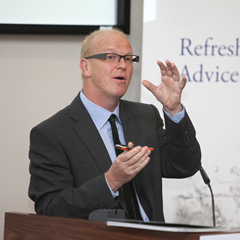Managing innovation: Charles Leadbeater
 Innovation expert Charles Leadbeater discusses the obstacles to public sector innovation with Owen McQuade.
Innovation expert Charles Leadbeater discusses the obstacles to public sector innovation with Owen McQuade.
Innovation is “not just about things like iPads”, Charles Leadbeater contends. Instead, it is an important concept that many organisations are not exploring thoroughly.
The public sector in particular needs to innovate, according to Leadbeater. However, too often, innovative ideas get trapped in “pockets” and “then get translated into policy at national scale, too fast.”
Tony Blair’s former innovation advisor states that the four main ingredients for innovation are to create the authority, generate and select ideas, develop and replicate those ideas, and exit the old systems, rather than replicating them.
“Creating the authority requires continual political leadership, but increasingly [that] needs to operate at all levels of an organisation,” Leadbeater tells agendaNi.
Crisis often prompts innovation. However, money “rarely sustains it” and “mad passion and ambition drives it.”
He says that the space for innovation will grow once an organisation realises: ‘what we have is not good enough’, ‘our needs are fundamentally changing’ and ‘new ways to organise ourselves are plentiful’.
When generating and selecting new ideas, “where you stand will determine what you see.” Organisations need to look at the outcomes for people and communities first, then at what change would mean for institutions and services, he contends.
Innovative ideas from inside and outside the public sector should be discussed and borrowed, Leadbeater adds.
“It’s very easy to set up pockets of innovation, either inside, [where] you’ll find people who’ve done amazing bits of work around particular issues within the public sector such as great re-offender schemes or an amazing school. And you’ll find pockets outside [such as] a social enterprise,” he explains.
“One of the most important things is that [organisations] need to find people who can bridge inside and outside and know how to talk both languages.”
Generating new ideas is particularly difficult for the public sector. There are two main barriers, according to Leadbeater.
“One big barrier is complacency; that people don’t recognise enough how, what they’re doing might be ineffective or out- dated,” he states.
In addition: “There aren’t enough differences of view about what should be done so it’s very difficult to break the mindset.”
The other barrier is the risk factor. “Risk needs to be constantly managed in the public sector. Taken in a strategic and intelligent way, that requires political leadership, money and time,” he says.
Ultimately, “innovation in the public sector takes time.” It is the same as a “big, hierarchical corporation in relation to innovation” and it has additional problems with “political and public risk,” Leadbeater says.
How innovation is developed and replicated is “undervalued in the public sector”, according to Leadbeater “because too much public service innovation adds to what we have rather than replacing it with something better.”
Whilst some organisations have become better at developing ideas, generation still relies on “turning it into a policy and then making it a mandate nationally”. Leadbeater believes there should be other options because that route can often become “clumsy”.
The private sector has a market incentive for innovation but there is no equivalent in the public sector.
Reaching the final stage (exit and duplication) can often be an ‘innovator’s dilemma’, whereby they need to convince colleagues that the old systems should be replaced.
In order to achieve that “you have to audit the current way of doing things to try and show [there will be] real cost of effectiveness,” Leadbeater states.
Innovators should “create attractive visions of what you might create”, explaining how the transition works and how it happens. In this way, people working in the organisation will see that “this way of doing it is better.”
Leadbeater’s final advice to innovators is to “build up the case that: ‘What we are doing isn’t good enough. What we could do is new, exciting and practical and it delivers results.’”





